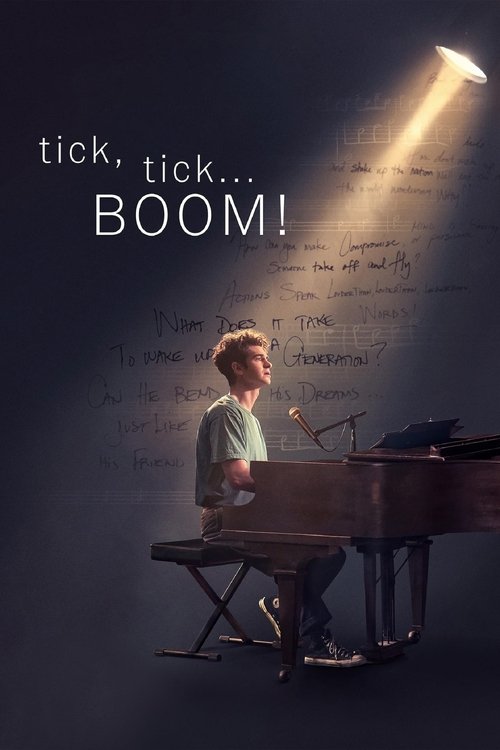
Ask Your Own Question
What is the plot?
The sun rises over the high desert of northwestern New Mexico, casting long shadows across the red earth and mesas. The air is still, the sky a vast dome of pale blue, and the silence is broken only by the whisper of wind through sagebrush. From the rugged landscape, two figures emerge--silent, luminous, almost spectral. They are not men, not spirits, but something in between: beings born of the land itself, shaped by the stories and breath of Na'nízhoozhí, the place the Navajo call Gallup. Their names are not spoken, but their presence is unmistakable--Anthony Roth Costanzo and Davóne Tines, their bodies moving with a grace that feels both ancient and new, as if they have stepped out of myth and into the present.
They walk barefoot across the cracked earth, their feet leaving no trace. The camera lingers on their faces, their eyes scanning the horizon with a mixture of curiosity and reverence. Costanzo's voice rises first, a clear tenor that cuts through the stillness, singing words that seem to come from the land itself: "Na'nízhoozhí, Na'nízhoozhí, the heart of Diné Bikéyah." Tines answers, his baritone deep and resonant, "Where the stories gather, where the people return." The music, composed by Matthew Aucoin, is sparse and haunting, a blend of Western opera and Navajo chant, the poetry by Jake Skeets weaving through the score like a river through sandstone.
The two beings move toward the town, their steps unhurried, their movements deliberate. The camera follows them as they pass through the outskirts of Gallup, the landscape shifting from open desert to the fringes of the reservation. The buildings are modest, weathered by time and wind, their colors faded by the sun. The streets are quiet, the air thick with the scent of piñon and dust. The beings pause at the edge of a small trading post, its windows filled with turquoise jewelry and woven rugs. A sign above the door reads "Na'nízhoozhí Trading Co." in both English and Navajo.
Inside, an elderly Navajo woman sits behind the counter, her face lined with years of laughter and sorrow. She looks up as the beings enter, her eyes narrowing slightly, as if she recognizes something in them that others cannot see. "You're not from here," she says, her voice soft but firm. "But you belong." Costanzo smiles, a gentle, knowing smile. "We are here to remember," he says. "To see what has been forgotten." The woman nods, her gaze drifting to a photograph on the wall--a black-and-white image of a young Navajo man in traditional dress, standing in front of a hogan. "He was my brother," she says. "He walked away and never came back. But the land remembers."
The beings leave the trading post and continue their journey through the town. They pass a group of children playing basketball in a dusty lot, their laughter echoing off the walls of the surrounding buildings. The beings stop to watch, their faces softening with something like nostalgia. Tines hums a tune, a melody that seems to come from nowhere and everywhere at once. The children notice him, their laughter fading as they stare at the strangers. One of the boys, a wiry kid with a mop of dark hair, steps forward. "Who are you?" he asks. Costanzo kneels, his eyes level with the boy's. "We are the ones who remember," he says. "The ones who carry the stories." The boy looks at him for a long moment, then grins. "Can you teach me a song?" Costanzo nods, and together they sing a simple melody, the boy's voice blending with Costanzo's in a harmony that feels both ancient and new.
As the sun begins to set, the beings make their way to the center of Gallup, the ceremonial heart of the Navajo Nation. The streets are busier now, filled with people returning from work, families gathering for dinner, the air alive with the sounds of conversation and laughter. The beings stand in the middle of the square, their presence drawing curious glances but no hostility. They look around, their eyes taking in the faces, the buildings, the life that pulses through the town. Tines speaks, his voice low and steady. "This is where we began," he says. "This is where we will end."
The camera pans across the square, showing the faces of the people--Navajo, Hispanic, Anglo, all living together in this place that is both a town and a symbol. The beings move through the crowd, their steps unhurried, their presence a quiet reminder of something deeper, something older. They pass a group of elders sitting on a bench, their faces weathered by time and sun. One of the elders, a man with a long white beard, looks up at them, his eyes sharp and knowing. "You're not from here," he says, echoing the words of the woman in the trading post. "But you belong." Costanzo nods. "We are here to remember," he says. "To see what has been forgotten." The elder smiles, a slow, gentle smile. "The land remembers," he says. "The stories remember."
As night falls, the beings make their way to the edge of the town, where the desert begins again. The stars are bright, the sky a vast dome of light and shadow. They stand together, looking out over the land, their faces bathed in the glow of the moon. Costanzo speaks, his voice soft but clear. "We have seen what has been forgotten," he says. "We have remembered what has been lost." Tines nods. "And now we return," he says. "To the land, to the stories, to the people."
The camera lingers on their faces as they begin to change, their bodies dissolving into the landscape, their forms merging with the earth and the sky. The music swells, a final, haunting melody that seems to come from the land itself. The beings are gone, but their presence remains, a quiet reminder of the stories that live on in the land and the people.
The final scene shows the town of Gallup, the stars above, the desert stretching out into the distance. The camera pans across the landscape, showing the faces of the people, the buildings, the life that pulses through the town. The music fades, leaving only the sound of the wind and the stars. The screen goes black, and the words "Na'nízhoozhí" appear, followed by "Gallup, New Mexico."
There are no deaths, no confrontations, no secrets revealed in the traditional sense. The story is not one of conflict or resolution, but of memory and belonging. The beings are not characters in the conventional sense, but symbols of the land and the people, their journey a metaphor for the connection between identity, place, and culture. The ending is not a conclusion, but a continuation, a reminder that the stories live on, that the land remembers, that the people return.
The film ends with a sense of peace and continuity, the connection to place and culture eternal. The journey is cyclical, the connection to the land and the stories unbroken. The beings are gone, but their presence remains, a quiet reminder of the stories that live on in the land and the people.
What is the ending?
In the ending of "Gallup (Na'nízhoozhí)," the protagonist, a young Navajo woman named Tazbah, confronts her past and the trauma that has shaped her life. She ultimately finds a sense of closure and empowerment, leading her to embrace her identity and heritage. The film concludes with Tazbah taking a step towards healing, symbolized by her reconnecting with her community and the land.
As the final scenes unfold, Tazbah stands at a crossroads, both literally and metaphorically. The sun sets behind her, casting a warm glow over the landscape, symbolizing the end of one chapter and the beginning of another. She reflects on her journey, the struggles she has faced, and the relationships that have influenced her.
In a poignant moment, Tazbah visits the gravesite of her mother, where she lays down a small offering, a gesture of respect and remembrance. This act signifies her acceptance of her past and the pain that comes with it. As she kneels, tears stream down her face, but there is a sense of relief in her expression. She whispers words of forgiveness, not only to her mother but also to herself, acknowledging the weight of her grief and the strength it has taken to confront it.
The scene shifts to Tazbah returning to her community, where she is greeted with warmth and understanding. The elders, who have watched her struggle, offer her words of wisdom and encouragement. They remind her of the importance of her heritage and the strength that comes from her roots. Tazbah listens intently, her heart swelling with a newfound sense of belonging.
In the final moments, Tazbah stands with her community, looking out over the vast expanse of the land that has been both a source of pain and healing for her. The camera captures her face, illuminated by the fading light, as she smiles softly, embodying a sense of hope and resilience. The film closes with a wide shot of the landscape, emphasizing the connection between Tazbah and her environment, a reminder that she is not alone in her journey.
The fate of each main character is intertwined with Tazbah's journey. Her mother, though deceased, plays a crucial role in Tazbah's emotional resolution. The elders of the community, who represent the wisdom of the past, continue to guide the younger generation, ensuring that the stories and traditions are passed down. Tazbah's friends, who have supported her throughout her struggles, stand by her side, reinforcing the theme of community and connection.
In this way, the ending of "Gallup (Na'nízhoozhí)" encapsulates the film's exploration of identity, healing, and the importance of community, leaving the audience with a sense of closure and hope for the future.
Is there a post-credit scene?
In the movie "Gallup" (Na'nízhoozhí), there is no post-credit scene. The film concludes its narrative without any additional scenes or content after the credits roll. The story wraps up with a focus on the emotional and thematic resolutions of the characters, leaving the audience with a sense of closure regarding the events that transpired throughout the film.
What motivates the main character, a young Navajo woman, to return to Gallup after years away?
The main character, a young Navajo woman named Tazbah, is motivated to return to Gallup due to a deep sense of longing for her roots and a desire to reconnect with her family and culture. She feels a pull towards her heritage, which she has been distanced from while living in the city. This journey is not just physical but also emotional, as she grapples with her identity and the expectations of her family.
How does Tazbah's relationship with her grandmother influence her journey in Gallup?
Tazbah's relationship with her grandmother is pivotal in her journey. Her grandmother represents the wisdom and traditions of their Navajo culture, and Tazbah seeks her guidance as she navigates her feelings of displacement. The grandmother's stories and teachings serve as a grounding force for Tazbah, helping her to understand the importance of her heritage and the strength of her community.
What challenges does Tazbah face upon her return to Gallup, and how do they affect her character development?
Upon her return to Gallup, Tazbah faces several challenges, including the disconnection from her community, the struggle to fit in after years away, and the emotional weight of family expectations. These challenges force her to confront her insecurities and ultimately lead to significant character development as she learns to embrace her identity and the complexities of her past.
What role does the setting of Gallup play in shaping the narrative and Tazbah's experiences?
The setting of Gallup plays a crucial role in shaping the narrative, as it is depicted as a vibrant yet challenging environment that reflects the struggles and resilience of the Navajo community. The landscapes, cultural landmarks, and local interactions serve as a backdrop for Tazbah's journey, highlighting the contrast between her past and present, and emphasizing the importance of place in her quest for belonging.
How does Tazbah's relationship with her childhood friend evolve throughout the film?
Tazbah's relationship with her childhood friend, who has remained in Gallup, evolves from a sense of nostalgia and familiarity to a deeper understanding and connection. Initially, their interactions are marked by the awkwardness of their time apart, but as they navigate their shared history and current struggles, they begin to support each other, ultimately leading to a rekindling of their bond that reflects growth and mutual respect.
Is this family friendly?
"Gallup (Na'nízhoozhí)" is a film that explores deep emotional themes and cultural narratives, which may not be suitable for all audiences, particularly children or sensitive viewers.
-
Themes of Loss and Grief: The film delves into the emotional struggles of the characters dealing with loss, which may be heavy for younger viewers.
-
Cultural Tensions: There are scenes that depict cultural misunderstandings and conflicts, which might be distressing for some.
-
Intense Emotional Moments: Characters experience significant emotional turmoil, including moments of anger, sadness, and despair that could be upsetting.
-
Substance Use: There are references to alcohol and its impact on the characters' lives, which may not be appropriate for children.
-
Violence and Threats: Some scenes may contain confrontational or threatening behavior that could be alarming.
These elements contribute to a narrative that is rich in emotional depth but may not be suitable for younger audiences or those sensitive to such themes.





















